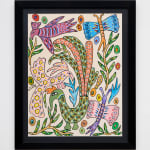BAYA Algerian, 1931-1998
Farfalle e pavoni [Butterflies and peacocks], 1980
Gouache and pencil on paper
Sheet: 65 x 50 cm | 25 5/8 x 19 3/4 in
Framed: 77 x 63 cm | 30 1/4 x 24 3/4 in
Framed: 77 x 63 cm | 30 1/4 x 24 3/4 in
BAYA (1931–1998), born Fatima Haddad in Algeria, is one of the most important and influential North African artists of the last century, renowned for her vivid, fantastical paintings that combine...
BAYA (1931–1998), born Fatima Haddad in Algeria, is one of the most important and influential North African artists of the last century, renowned for her vivid, fantastical paintings that combine elements from her Arab and Kabyle heritage with French Modernism and Surrealism. Baya was self-taught, and her groundbreaking career strongly influenced North African postcolonial art movements from the mid-20th century onward.
Although championed by key members of the Parisian avant-garde, including André Breton and Henri Matisse, Baya remained true to her unique vision and consistently challenged established national and cultural norms. Her work is a powerful reflection of personal experiences, particularly those rooted in her childhood. Baya was discovered by French art dealer Aimé Maeght, who was captivated by her work during a visit to Algeria. Her paintings were first exhibited in a solo show at Galerie Maeght in Paris in 1947, when she was just 16 years old.
She became the toast of Paris, praised by figures like André Breton, who organized the International Surrealist Exhibition and declared, “Baya is queen.” Her unique style also captured the attention of Pablo Picasso, who invited her to collaborate with him at the Madoura ceramics studio from 1948 to 1952, and later made her a muse for his Women of Algiers series. In her paintings, Baya presented an alternative way of seeing. She depicted joyful women, flora, and fauna in recurring patterns reminiscent of the arabesque of Islamic art. Her direct portrayals of the female body and her world challenged stereotypes, in contrast to the exoticized and sexualized representations of women prevalent in European art of the time.
Her work has been featured in major retrospectives, including 'Baya', Fondation Maeght (2025); B'aya Mahieddine: Lasting Impressions', Sharjah Art Museum (2021); 'Baya: Icon of Algerian Painting. Women in their Garden', Institut du Monde Arabe, Paris (2022–2023); and 'Baya: Woman of Algiers', Grey Art Gallery, New York (2018). Baya was also included in the Venice Biennale in both 2022 (The Milk of Dreams) and 2024 (Foreigners Everywhere).
Although championed by key members of the Parisian avant-garde, including André Breton and Henri Matisse, Baya remained true to her unique vision and consistently challenged established national and cultural norms. Her work is a powerful reflection of personal experiences, particularly those rooted in her childhood. Baya was discovered by French art dealer Aimé Maeght, who was captivated by her work during a visit to Algeria. Her paintings were first exhibited in a solo show at Galerie Maeght in Paris in 1947, when she was just 16 years old.
She became the toast of Paris, praised by figures like André Breton, who organized the International Surrealist Exhibition and declared, “Baya is queen.” Her unique style also captured the attention of Pablo Picasso, who invited her to collaborate with him at the Madoura ceramics studio from 1948 to 1952, and later made her a muse for his Women of Algiers series. In her paintings, Baya presented an alternative way of seeing. She depicted joyful women, flora, and fauna in recurring patterns reminiscent of the arabesque of Islamic art. Her direct portrayals of the female body and her world challenged stereotypes, in contrast to the exoticized and sexualized representations of women prevalent in European art of the time.
Her work has been featured in major retrospectives, including 'Baya', Fondation Maeght (2025); B'aya Mahieddine: Lasting Impressions', Sharjah Art Museum (2021); 'Baya: Icon of Algerian Painting. Women in their Garden', Institut du Monde Arabe, Paris (2022–2023); and 'Baya: Woman of Algiers', Grey Art Gallery, New York (2018). Baya was also included in the Venice Biennale in both 2022 (The Milk of Dreams) and 2024 (Foreigners Everywhere).
Provenance
Artpaugee, July 2024;Private collection (Middle East)
Join our mailing list
* denotes required fields
We will process the personal data you have supplied to communicate with you in accordance with our Privacy Policy. You can unsubscribe or change your preferences at any time by clicking the link in our emails.
![BAYA, Farfalle e pavoni [Butterflies and peacocks], 1980](https://artlogic-res.cloudinary.com/w_1600,h_1600,c_limit,f_auto,fl_lossy,q_auto/artlogicstorage/richardsaltoun/images/view/184ade03b930edb0e5b89e3d03fbda96j/richardsaltoun-baya-farfalle-e-pavoni-butterflies-and-peacocks-1980.jpg)
![BAYA, Farfalle e pavoni [Butterflies and peacocks], 1980](https://artlogic-res.cloudinary.com/w_1600,h_1600,c_limit,f_auto,fl_lossy,q_auto/artlogicstorage/richardsaltoun/images/view/b1aee762485398a372fdf9f7358815dcj/richardsaltoun-baya-farfalle-e-pavoni-butterflies-and-peacocks-1980.jpg)

